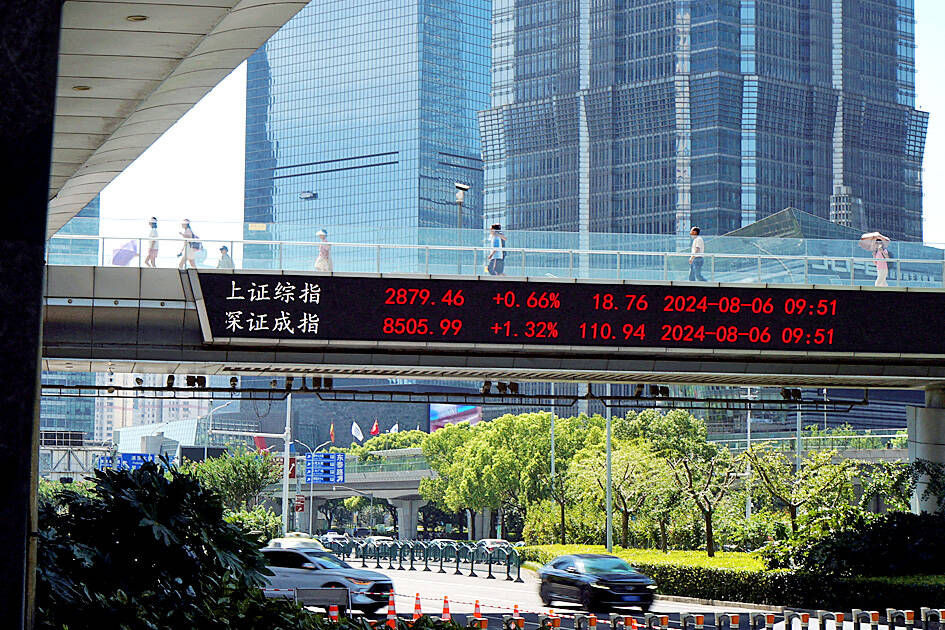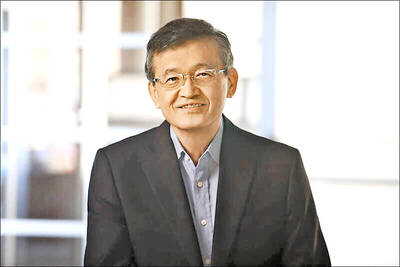The world-beating rally in Chinese stocks is failing to convince many global fund managers and strategists.
Invesco Ltd, JPMorgan Asset Management, HSBC Global Private Banking and Wealth, and Nomura Holdings Inc are among those viewing the recent rebound with skepticism and waiting for Beijing to back up its stimulus pledges with real money. Some are also concerned many stocks are already reaching overvalued levels.
Chinese shares have skyrocketed since late last month as a barrage of economic, financial and market-support measures reinvigorated investor confidence and prompted the likes of Goldman Sachs Group Inc to upgrade the nation’s stocks to overweight.

Photo: Nicoco Chan, Reuters
The Hang Seng China Enterprises Index, which comprises Chinese stocks listed in Hong Kong, has jumped more than 35 percent over the past month, making it the best performer among more than 90 global equity gauges tracked by Bloomberg, while raising concern it might be too far, too fast.
“In the short term, sentiment could overshoot, but people will go back to fundamentals,” Invesco chief investment officer for Hong Kong and mainland China Raymond Ma (馬磊) said.
“Because of this rally, some stocks have become really overvalued” and they lack a clear value proposition based on their likely earnings performance, he said.
Stimulus announced by Beijing has included interest rate cuts, freeing up of cash at banks, billions of dollars of liquidity support for stocks and a vow to end the long-term slide in property prices. The Chinese National Development and Reform Commission is to host a press conference today to discuss the implementation of a package of incremental economic policies.
While there is plenty of optimism that could underpin a sustainable equity rally, there have been a number of false dawns before, most recently a rally in February that completely unwound.
Ma said he is in no rush to add to his investments now.
“There are a group of stocks whose share prices are up by 30 percent to 40 percent and almost at historical highs,” he said. “Whether in the next 12 months the fundamentals will be as good as before their peak, that’s more uncertain to me. That would be the category we would like to trim.”
Hong Kong’s benchmark Hang Seng Index yesterday closed up 1.6 percent, while China’s markets are to reopen today after the Golden Week holiday.
JPMorgan Asset Management said it is just as cautious.
“Additional policy steps would be needed to boost economic activity and confidence,” JPMorgan Asia Pacific chief market strategist Tai Hui (許長泰) said. “The policies announced so far can help to smoothen out the deleveraging process, but the balance sheet repairing would still need to take place.”
Hui also pointed to global uncertainties that might crimp the nascent stock rally.
“With the US elections only a month away, many investors would argue that the US view of China as an economic and geopolitical rival is a bipartisan consensus,” he said.
“Foreign investors may choose to wait for economic data to bottom out and for this new policy direct to solidify,” Hui added.
HSBC Global Private Banking said it remains concerned that the steps China has taken are npt enough to reverse the nation’s slowing long-term growth outlook.
“More significant fiscal easing is still needed to sustain the recovery momentum and shore up growth to achieve the 5 percent 2024 GDP growth target,” HSBC chief investment officer for Asia Fan Cheuk Wan (范卓雲) said. “For now, we stay neutral on mainland China and Hong Kong equities based on our expectation of China’s GDP growth decelerating from 4.9 percent in 2024 to 4.5 percent in 2025.”
Nonetheless, Goldman Sachs has upgraded its call on Chinese stocks to overweight and said indexes tracking the nation’s equities might rise another 15 percent to 20 percent if authorities deliver on policy measures.
Beijing’s recent stimulus announcements “have led the market to believe that policymakers have become more concerned about taking sufficient action to curtail left tail growth risk,” Goldman Sachs strategists including Timothy Moe wrote in a note on Saturday.

Application-specific integrated circuit designer Faraday Technology Corp (智原) yesterday said that although revenue this quarter would decline 30 percent from last quarter, it retained its full-year forecast of revenue growth of 100 percent. The company attributed the quarterly drop to a slowdown in customers’ production of chips using Faraday’s advanced packaging technology. The company is still confident about its revenue growth this year, given its strong “design-win” — or the projects it won to help customers design their chips, Faraday president Steve Wang (王國雍) told an online earnings conference. “The design-win this year is better than we expected. We believe we will win

Intel Corp chief executive officer Lip-Bu Tan (陳立武) is expected to meet with Taiwanese suppliers next month in conjunction with the opening of the Computex Taipei trade show, supply chain sources said on Monday. The visit, the first for Tan to Taiwan since assuming his new post last month, would be aimed at enhancing Intel’s ties with suppliers in Taiwan as he attempts to help turn around the struggling US chipmaker, the sources said. Tan is to hold a banquet to celebrate Intel’s 40-year presence in Taiwan before Computex opens on May 20 and invite dozens of Taiwanese suppliers to exchange views

Chizuko Kimura has become the first female sushi chef in the world to win a Michelin star, fulfilling a promise she made to her dying husband to continue his legacy. The 54-year-old Japanese chef regained the Michelin star her late husband, Shunei Kimura, won three years ago for their Sushi Shunei restaurant in Paris. For Shunei Kimura, the star was a dream come true. However, the joy was short-lived. He died from cancer just three months later in June 2022. He was 65. The following year, the restaurant in the heart of Montmartre lost its star rating. Chizuko Kimura insisted that the new star is still down

While China’s leaders use their economic and political might to fight US President Donald Trump’s trade war “to the end,” its army of social media soldiers are embarking on a more humorous campaign online. Trump’s tariff blitz has seen Washington and Beijing impose eye-watering duties on imports from the other, fanning a standoff between the economic superpowers that has sparked global recession fears and sent markets into a tailspin. Trump says his policy is a response to years of being “ripped off” by other countries and aims to bring manufacturing to the US, forcing companies to employ US workers. However, China’s online warriors